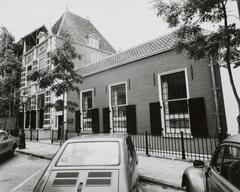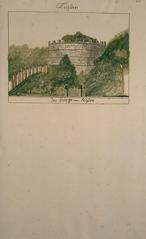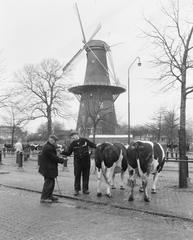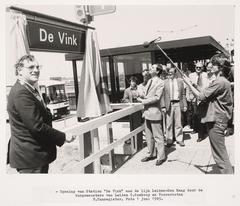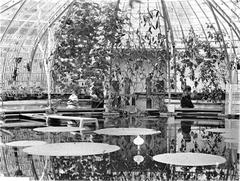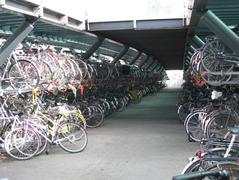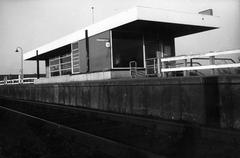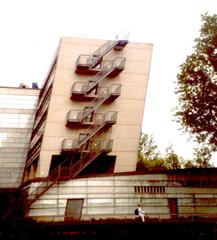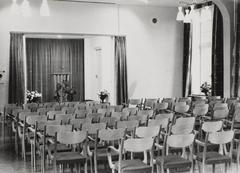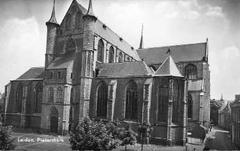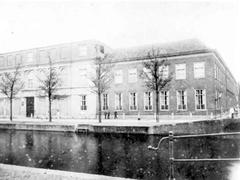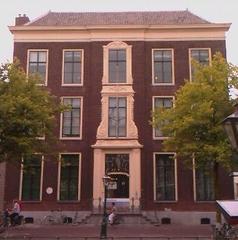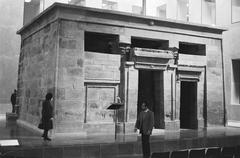Doelenpoortsbrug Leiden: Visiting Hours, Tickets, and Historical Sites Guide
Date: 04/07/2025
Introduction
The Doelenpoortsbrug is one of Leiden’s most cherished historical landmarks, seamlessly blending centuries-old architecture with the vibrant life of this Dutch city. Located near the iconic Doelenpoort city gate, the bridge not only connects neighborhoods over picturesque canals but also serves as a tangible link to Leiden’s storied past—from its role in city defenses to its significance in local festivals and daily life. This comprehensive guide provides everything visitors need to know about the Doelenpoortsbrug: its historical context, architectural features, visitor accessibility, nearby attractions, and practical tips for making the most of your visit.
Table of Contents
- Historical Overview of Doelenpoortsbrug
- Architectural Features and Restoration
- Role in Leiden’s Urban and Cultural Development
- Practical Visitor Information
- Nearby Attractions and Walking Routes
- Events and Cultural Activities
- Photography and Social Media Tips
- Frequently Asked Questions (FAQ)
- Conclusion and Visitor Resources
- Sources
Historical Overview of Doelenpoortsbrug
Origins and Historical Context
Constructed around 1645, the Doelenpoortsbrug is a quintessential example of a Dutch stone arch bridge from the Golden Age. Its name derives from the adjacent Doelenpoort, a city gate historically associated with Leiden’s civic guard (schutterij). The “Doelen” referred to archery ranges or guildhouses for these militias, which played a pivotal role in urban defense and community organization during the Middle Ages and Renaissance (Leiden History 101).
The bridge and gate formed part of Leiden’s extensive defensive works, enabling secure passage of troops, goods, and residents between the fortified center and outlying districts. Their strategic placement highlights the essential function bridges played in both military logistics and daily urban life (Facts About Leiden).
Key Role in Leiden’s Development
Leiden’s rapid growth during the Dutch Golden Age saw the expansion of its canal network and infrastructure. The Doelenpoortsbrug was integral to this evolution, supporting the movement of goods and people as the city became a center for trade, textiles, and academia (Travellifebalance Guide). Its proximity to the Doelenpoort and shooting ranges also made it a hub for civic ceremonies, parades, and market activity.
Architectural Features and Restoration
Design and Materials
The Doelenpoortsbrug exemplifies classic Dutch stone arch bridge design—low, broad arches constructed from durable brick and stone, allowing for both pedestrian and cart traffic. Decorative wrought-iron railings and period-appropriate paving (brick or cobblestone) add to its historical charm and functionality (architecturecourses.org). The bridge’s low profile and wide span ensure accessibility, while gentle approaches accommodate pedestrians and cyclists of all ages and abilities.
Maintenance and Preservation
Managed by the Leiden municipality, ongoing restoration and maintenance ensure the bridge’s structural integrity and historical authenticity. Recent efforts have incorporated eco-friendly materials and native plantings, supporting both heritage conservation and urban biodiversity (architecturecourses.org). The bridge’s historical features are highlighted during annual heritage events and walking tours.
Role in Leiden’s Urban and Cultural Development
Civic and Academic Life
The bridge’s location near Leiden University—founded in 1575 as a tribute to the city’s resistance during the Spanish siege—made it a vital route for students, scholars, and visitors. Today, it remains a conduit for intellectual exchange and community engagement, linking academic institutions, museums, and historic sites (Leiden University History).
Community and Festivals
The Doelenpoortsbrug is woven into Leiden’s cultural calendar. During events like Leidens Ontzet (October 3rd), the Peurbakkentocht boat parade, and Rembrandt Days, the bridge serves as a gathering point and scenic backdrop for celebrations, processions, and performances (Visit Leiden). It is also a favorite spot during the annual 100 Bruggenloop (100 Bridges Run), which highlights Leiden’s rich network of historic canal crossings (DagjeLeiden: 100 Bruggenloop).
Practical Visitor Information
Visiting Hours and Admission
- Hours: The Doelenpoortsbrug is a public bridge accessible 24 hours a day, all year round.
- Admission: No tickets or entrance fees are required; access is entirely free (Wikipedia: Leiden).
Accessibility
- The bridge is designed to accommodate both pedestrians and cyclists.
- The surface is flat and paved, making it generally suitable for wheelchair users and strollers, though adjacent streets may be cobbled or uneven.
- During busy times, such as festivals or weekends, exercise caution and allow room for cyclists (townsofeurope.com).
Getting There
- By Train: Leiden Centraal Station is a 15-minute walk from the bridge, with direct rail connections to Amsterdam, The Hague, and Rotterdam (Leiden Holland).
- By Bus: Several bus lines serve the city center, with stops within minutes of the Doelenpoortsbrug.
- By Bike: Leiden is highly bike-friendly, with dedicated lanes and bike parking near the bridge.
- By Car: Parking is limited in the city center; use nearby garages such as Haarlemmerstraat or Lammermarkt (WildTrips).
Nearby Attractions and Walking Routes
The Doelenpoortsbrug is an ideal starting point for exploring Leiden’s historic core:
- Doelenpoort: The 17th-century city gate adjacent to the bridge (Wikipedia).
- Pieterskerk: A 14th-century church with links to the Pilgrim Fathers (Try Travel).
- Museum De Lakenhal: The city’s museum of art and textile history (Try Travel).
- Rijksmuseum van Oudheden: The National Museum of Antiquities (WildTrips).
- Leiden’s Canals and Courtyards: Explore scenic waterways and hidden hofjes (courtyards) nearby (Holland Times).
Self-guided and guided walking tours—including the Rembrandt Route—commonly feature the Doelenpoortsbrug as a highlight (DutchReview, Open Monumentendagen Leiden).
Events and Cultural Activities
- Leidens Ontzet (October 3rd): City-wide festival commemorating the breaking of the Spanish siege in 1574.
- Peurbakkentocht (July): Festive boat parade along the canals.
- Rembrandt Days: Cultural events and guided walks celebrating Rembrandt’s Leiden roots.
- 100 Bruggenloop (September): Running event crossing 100 of Leiden’s bridges (DagjeLeiden: Events Calendar).
For up-to-date events and tours, consult the Leiden event calendar.
Photography and Social Media Tips
- Best Light: Early morning and late afternoon offer optimal lighting for photos.
- Views: Capture the bridge’s arches with reflections in the canal, the Doelenpoort, and surrounding historic facades (Tourist Places Guide).
- Hashtags: Use #Leiden, #Doelenpoortsbrug, and #DiscoverLeiden on social posts.
- Virtual Tours: High-resolution images and official virtual tours are available via the city’s tourism website.
Frequently Asked Questions (FAQ)
Q: Are tickets required to visit the Doelenpoortsbrug?
A: No, the bridge is a public thoroughfare and free to access at all times.
Q: What are the visiting hours?
A: The Doelenpoortsbrug is accessible 24/7, every day of the year.
Q: Is the bridge accessible for people with disabilities?
A: The bridge itself is generally wheelchair accessible, but some nearby streets may be cobbled or narrow.
Q: Are guided tours available?
A: Yes, local organizations and the Leiden tourist office offer guided walks that include the Doelenpoortsbrug (Visit Leiden).
Q: What else can I visit nearby?
A: Attractions like the Doelenpoort, Pieterskerk, Museum De Lakenhal, Rijksmuseum van Oudheden, and scenic canal walks are all within easy reach.
Safety, Etiquette, and Responsible Tourism
- Safety: Always stay aware of cyclists and fellow pedestrians, especially during busy times (WildTrips).
- Etiquette: Keep right on the bridge to allow others to pass, avoid littering, and respect the historic environment—do not attach locks or graffiti.
- Support Local: Patronize nearby cafes and shops to help sustain the area’s vibrant character (Holland Times).
Conclusion and Visitor Resources
The Doelenpoortsbrug is not merely a crossing—it is a living monument to Leiden’s resilience, architectural beauty, and cultural vibrancy. Whether you’re exploring Leiden’s rich canal network, participating in local festivals, or simply enjoying the scenic views, this bridge offers a unique window into the city’s past and present.
For more information, download the Audiala mobile app for detailed travel guides and real-time updates. Visit the Leiden Tourist Information website or stop by the VVV Leiden office for maps, tour bookings, and expert advice.
Sources
- Leiden History 101
- Facts About Leiden
- Travellifebalance Guide
- Leiden University History
- Wikipedia: Leiden
- Open Monumentendagen Leiden
- Visit Leiden
- DutchReview
- Tourist Places Guide
- Holland Times
- Kimkim
- WildTrips
- Try Travel
- townsofeurope.com
- architecturecourses.org
- DagjeLeiden: 100 Bruggenloop
- Leiden Holland
